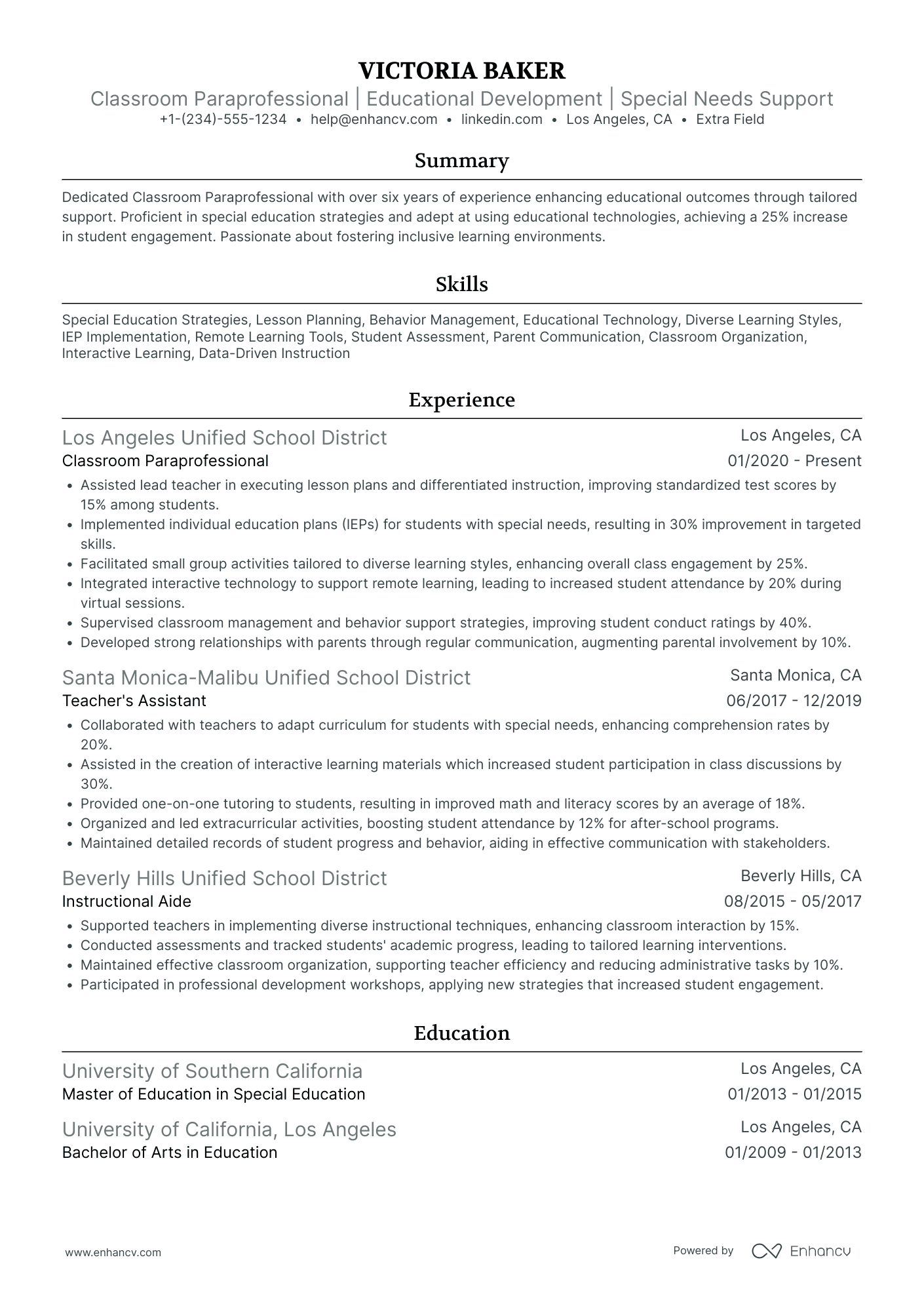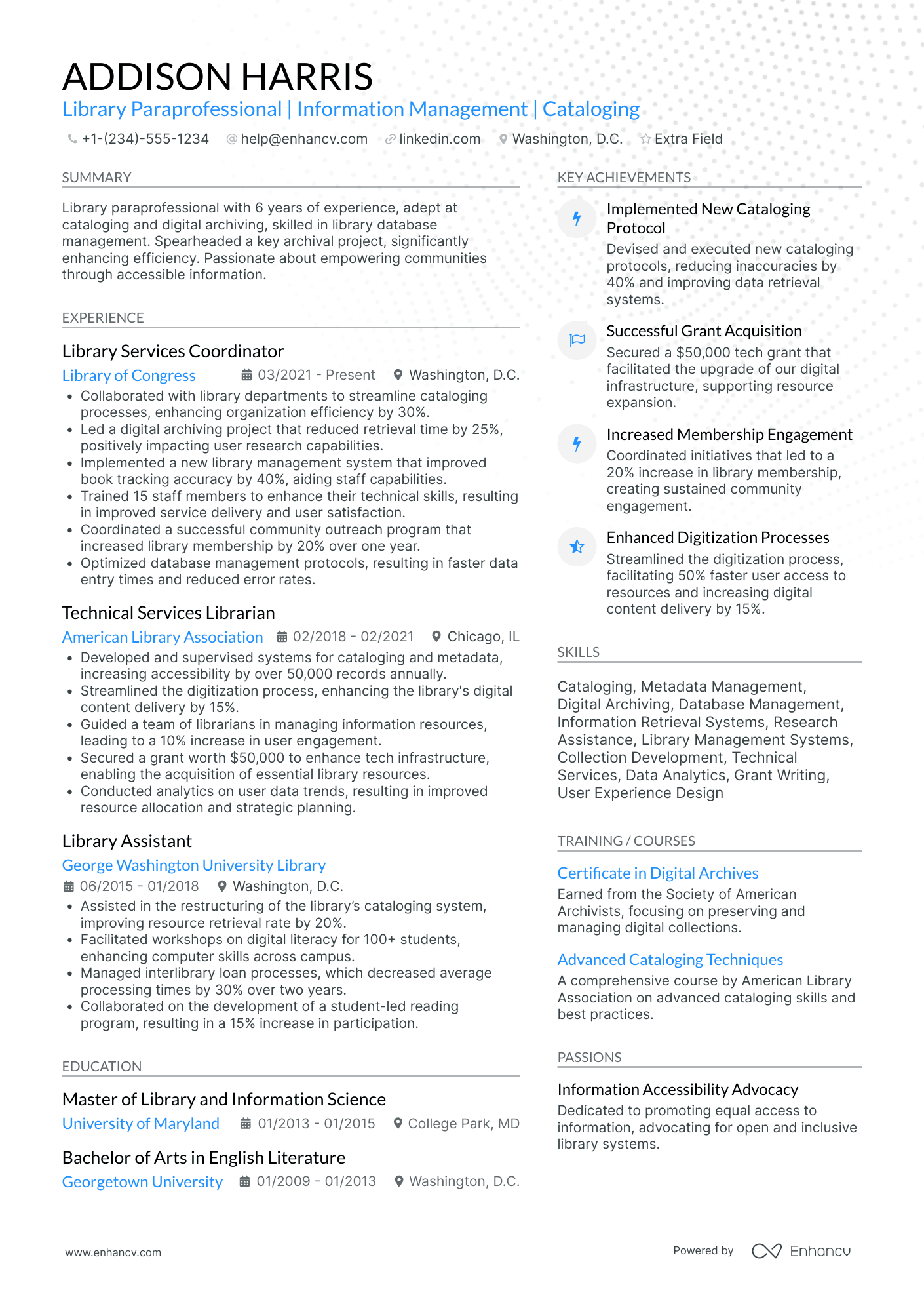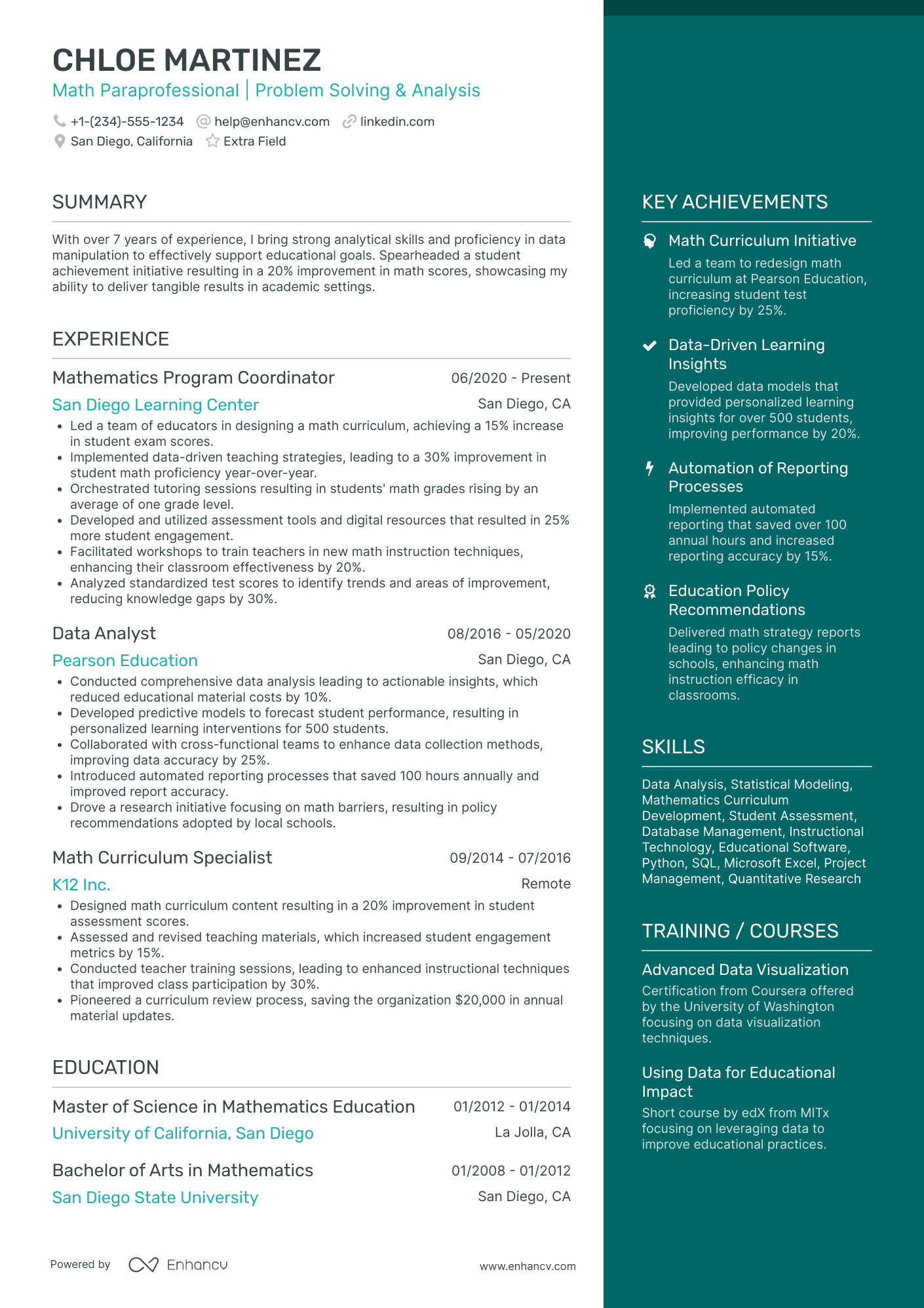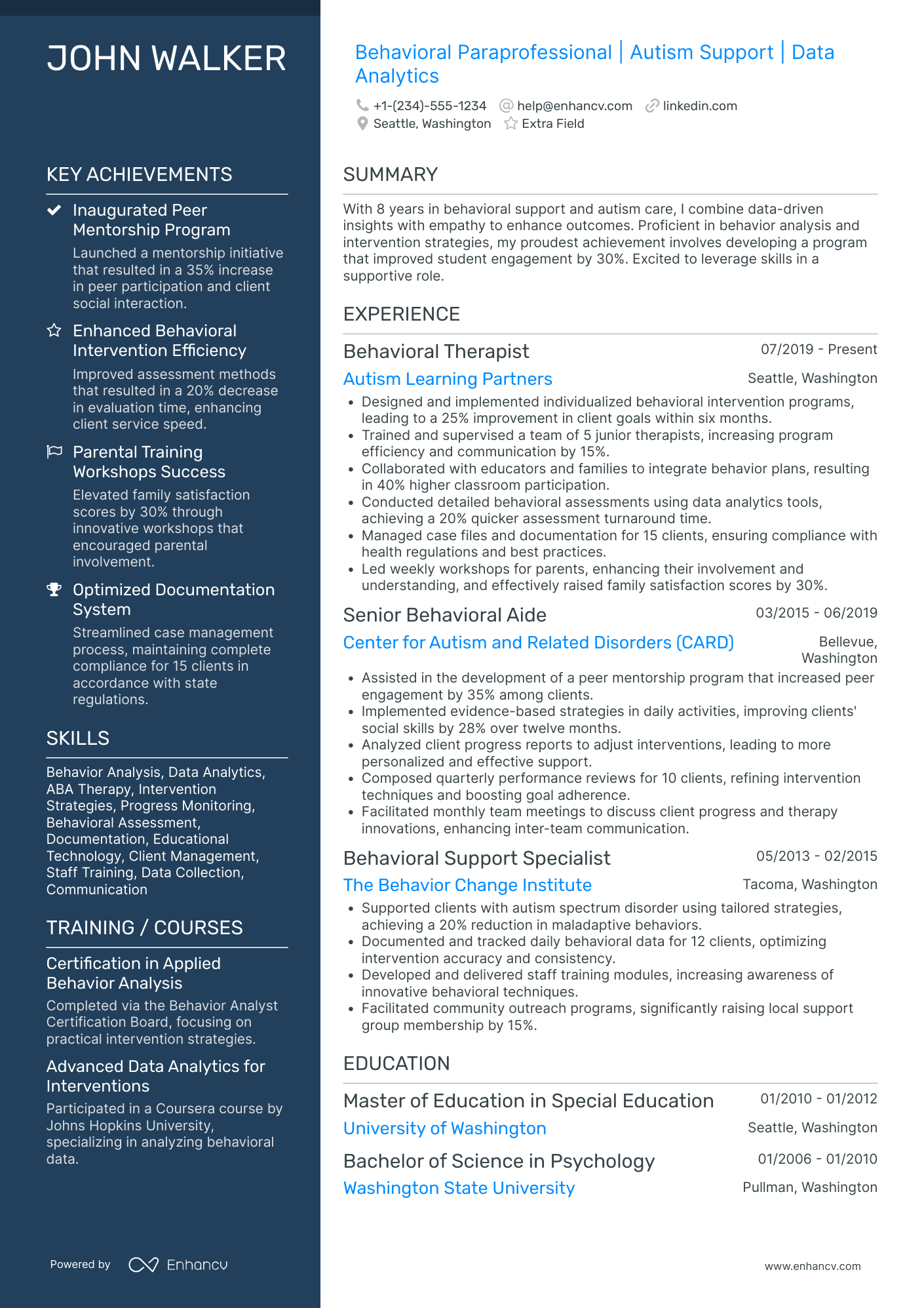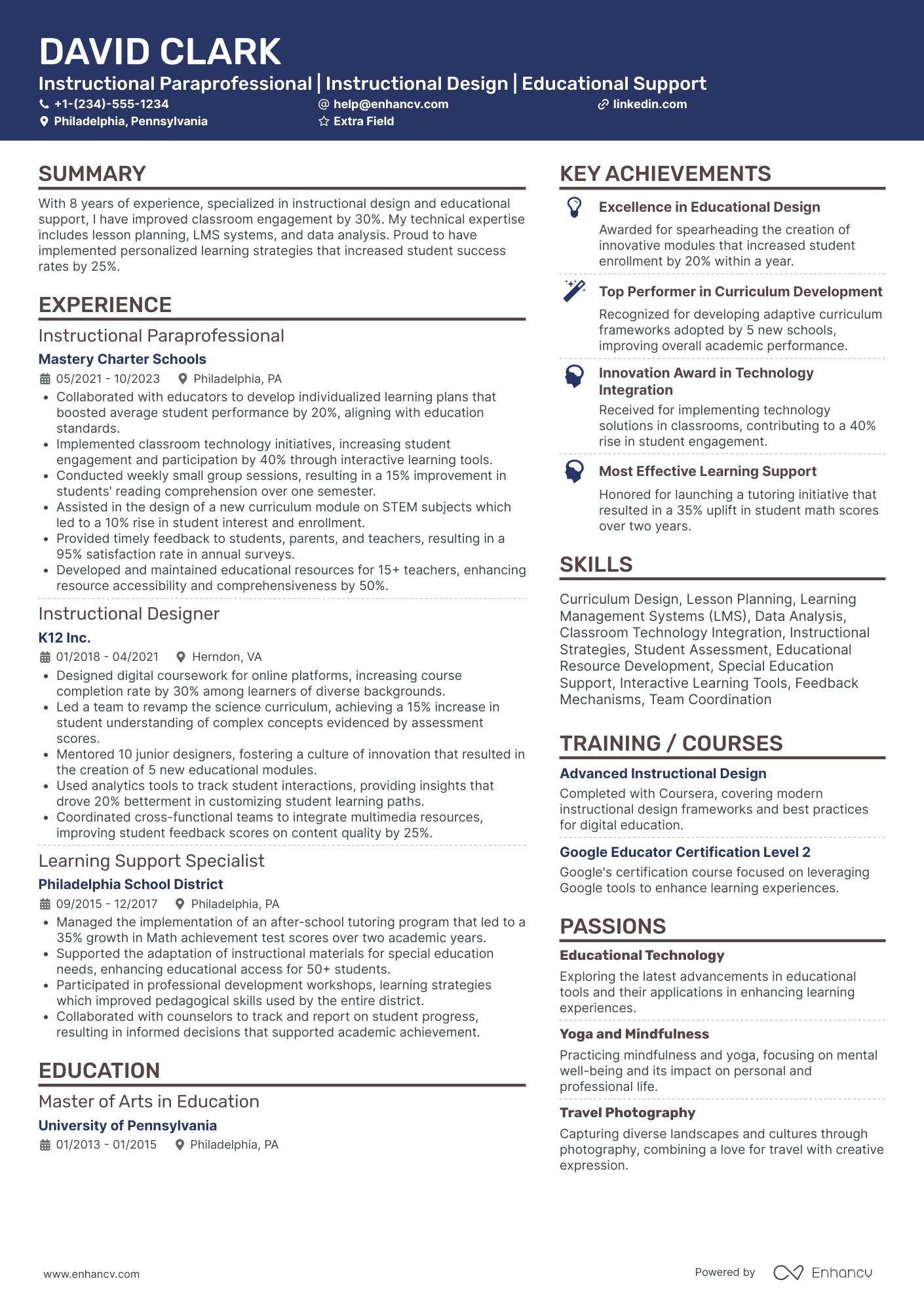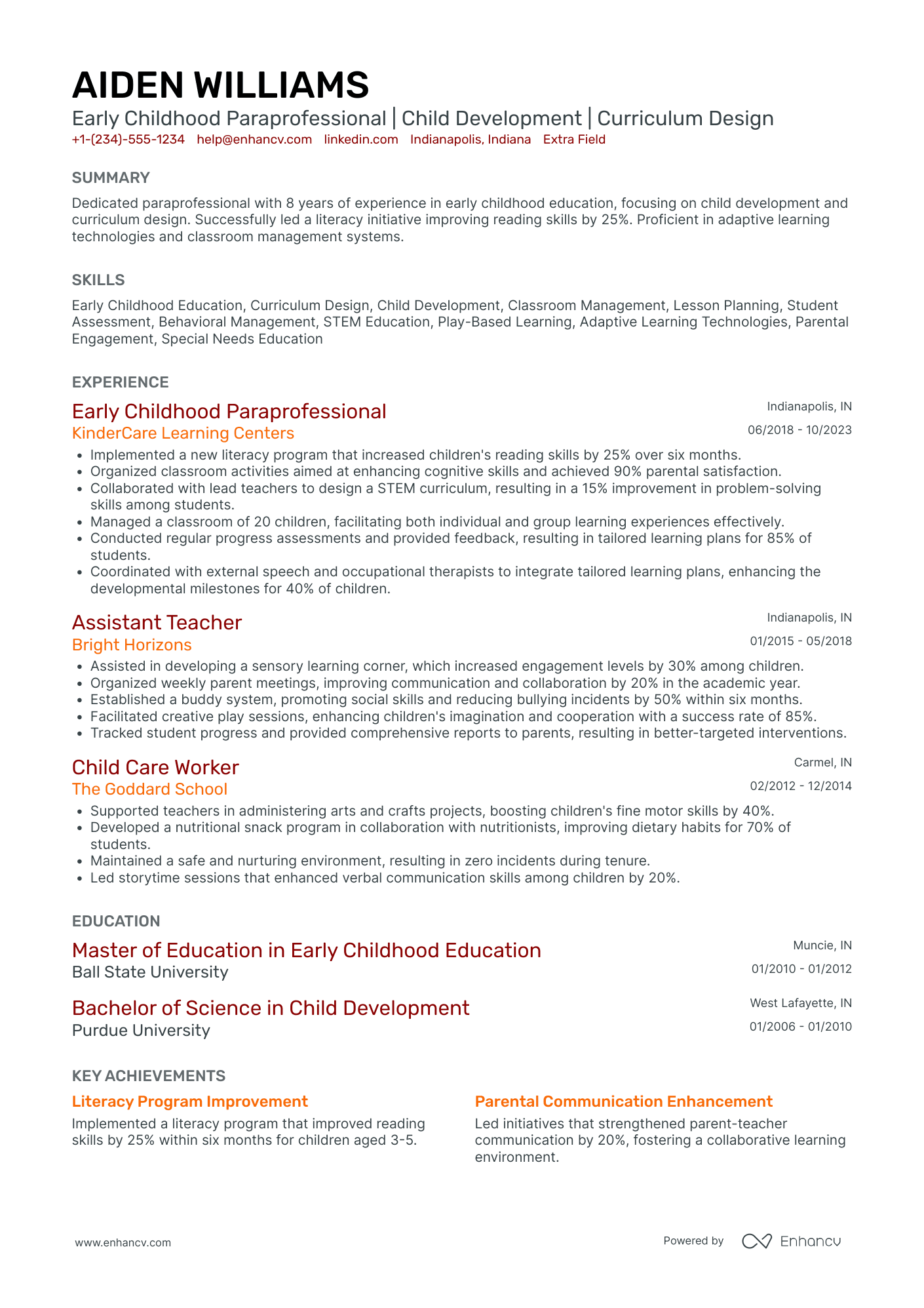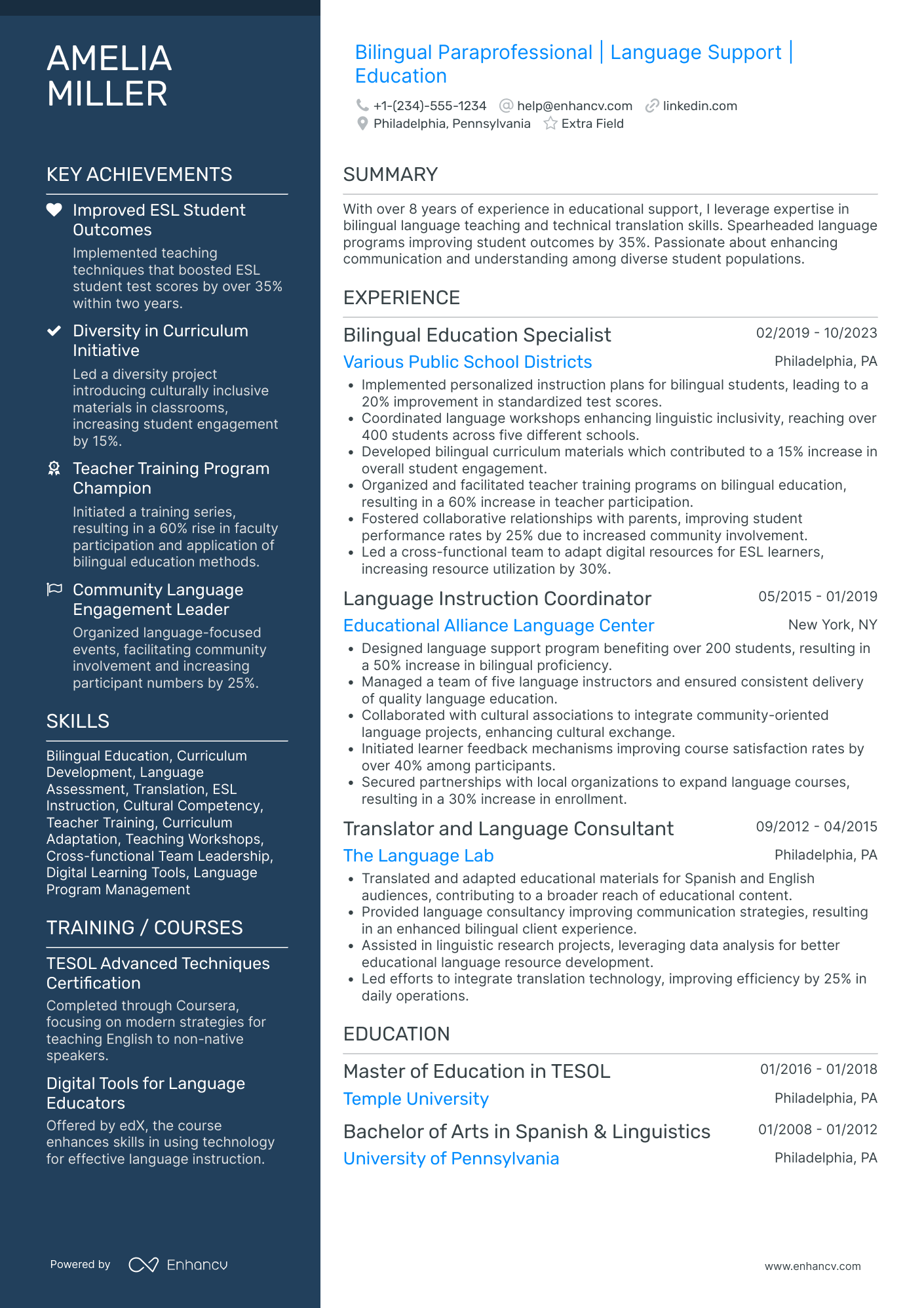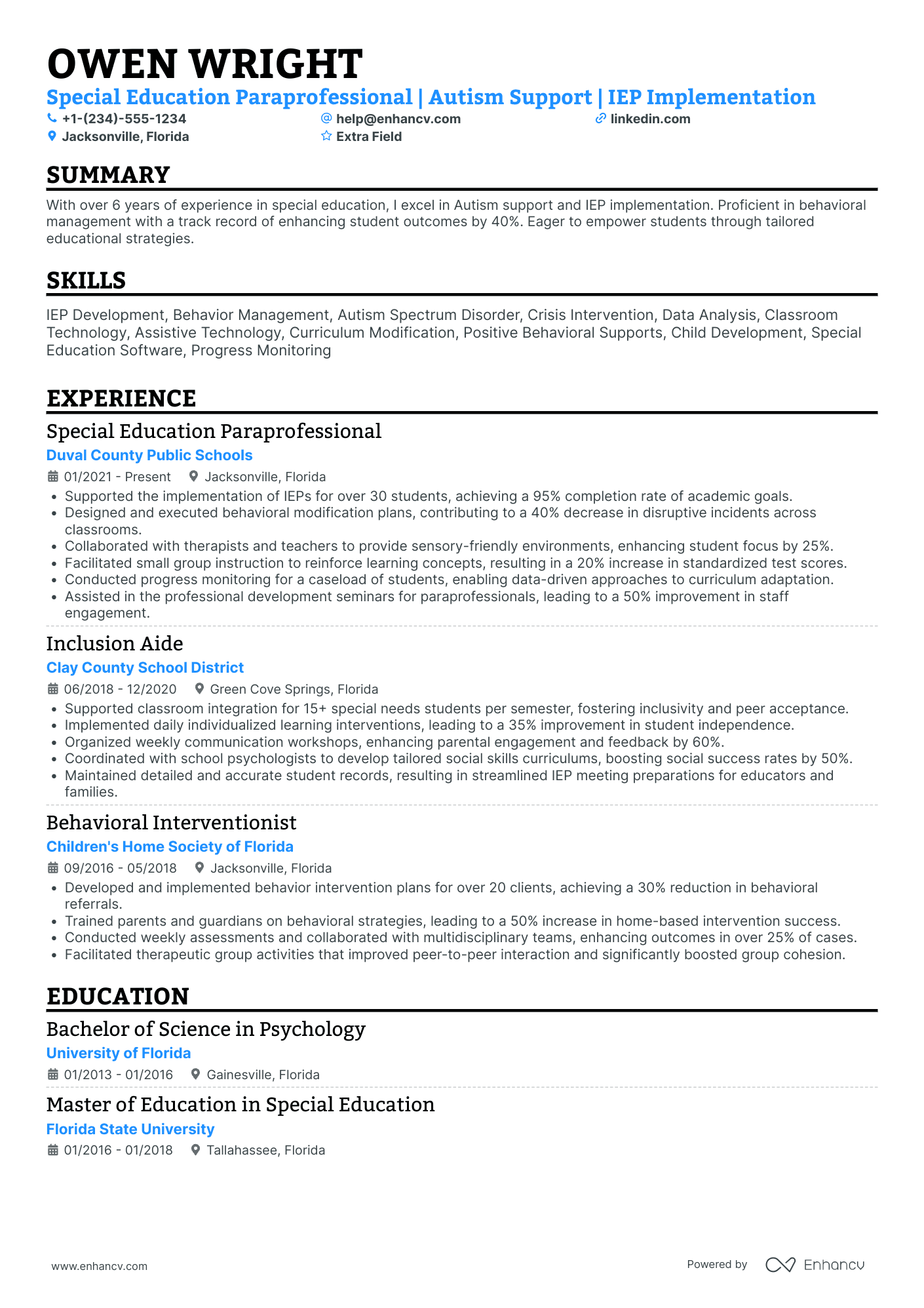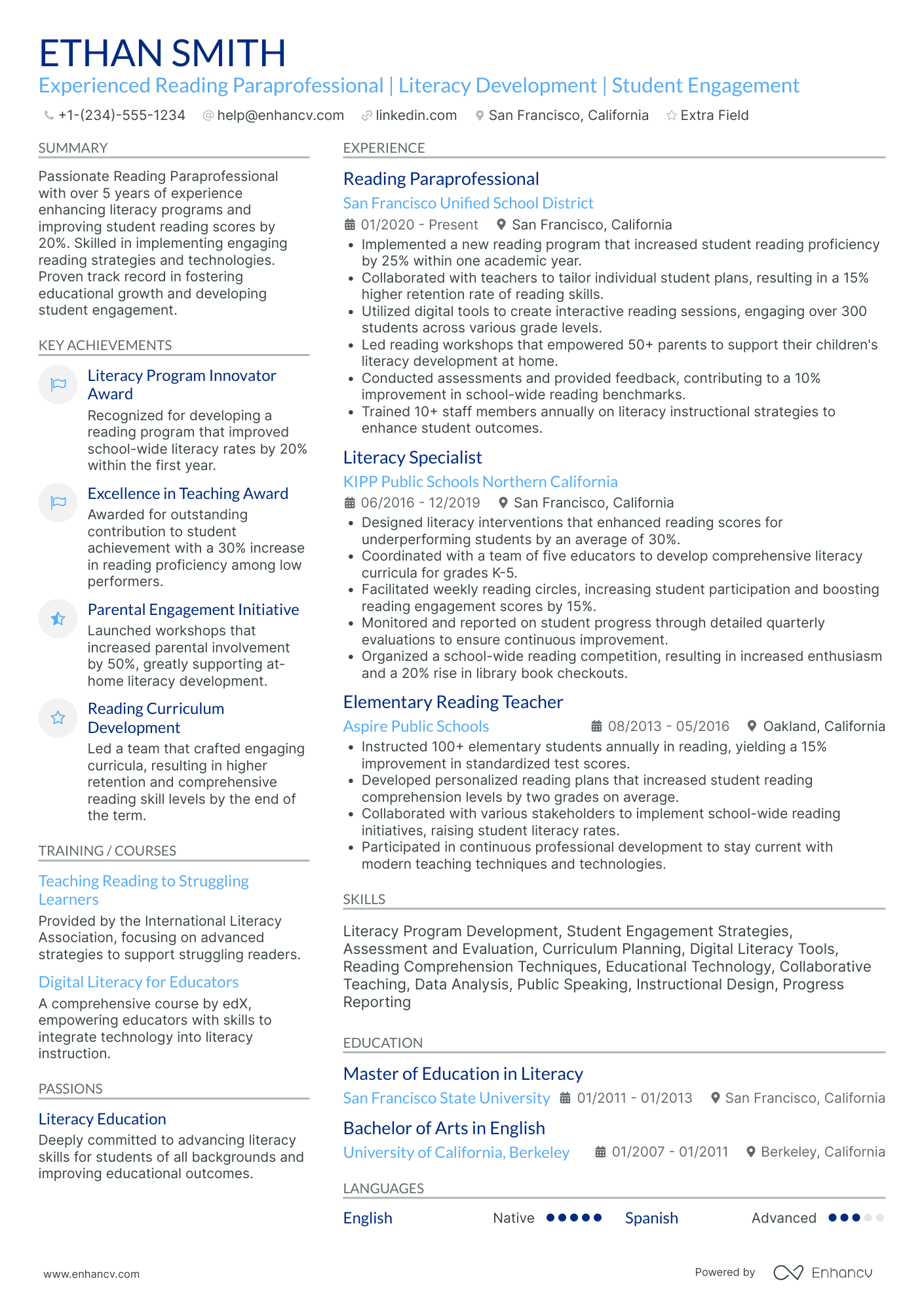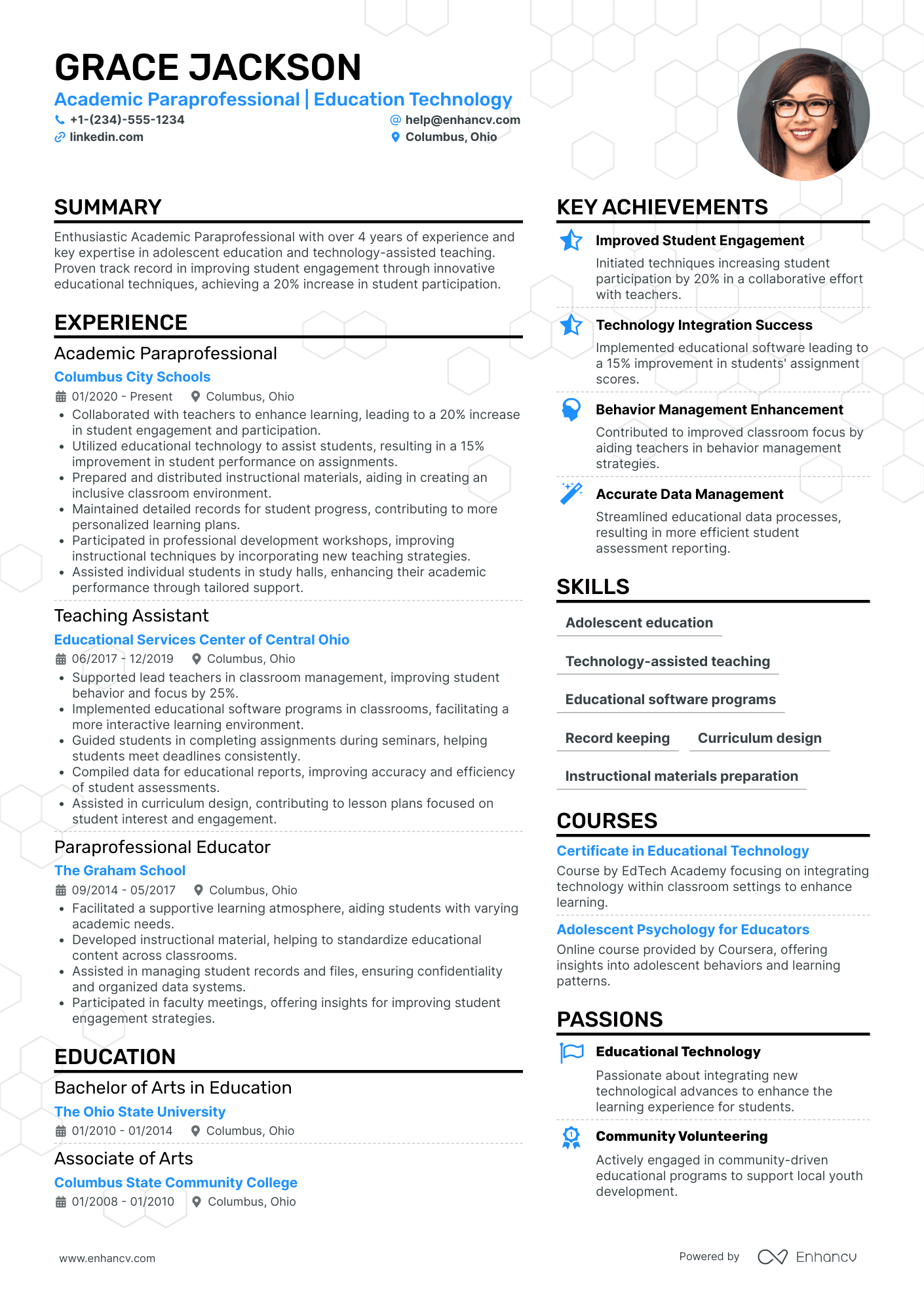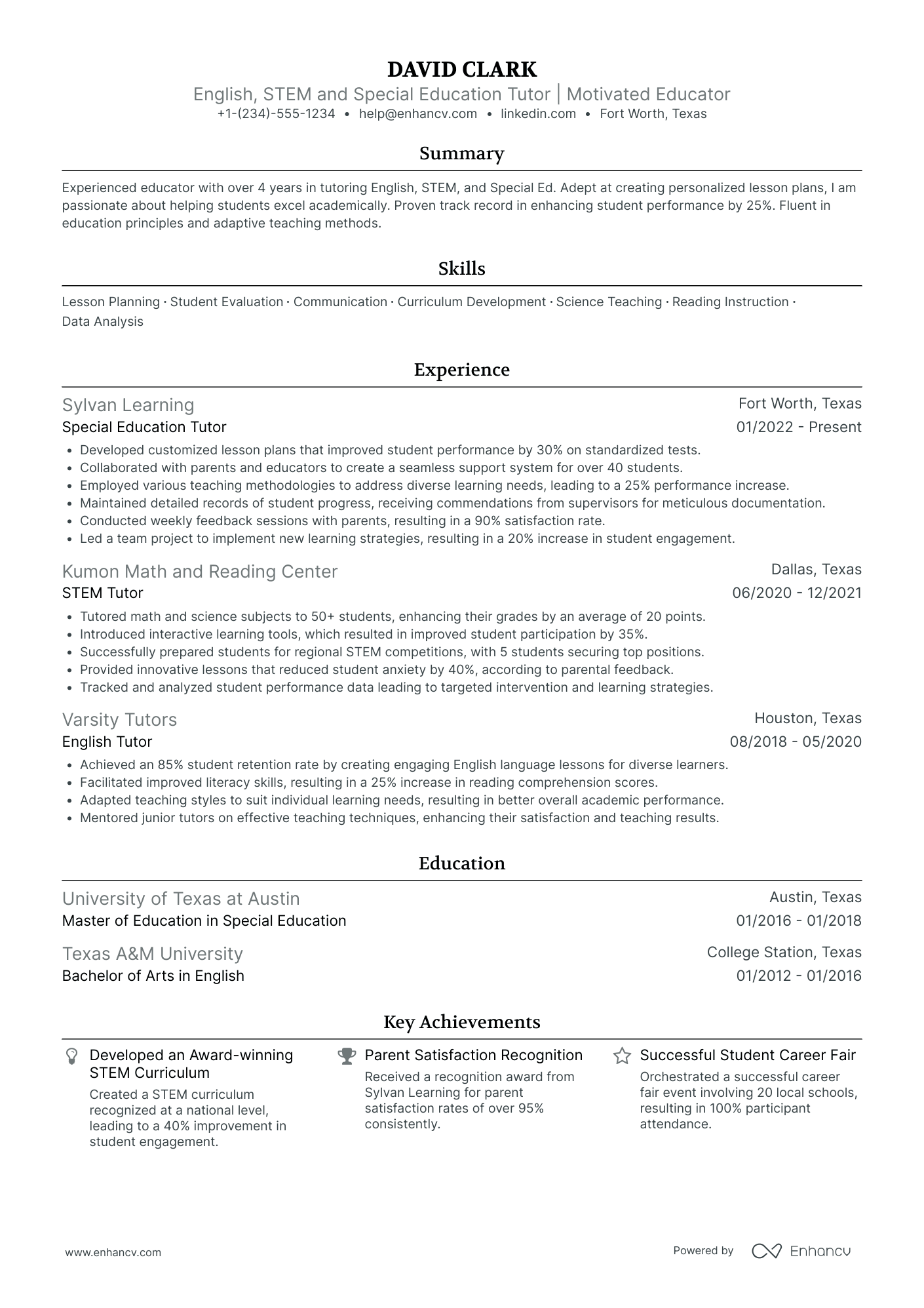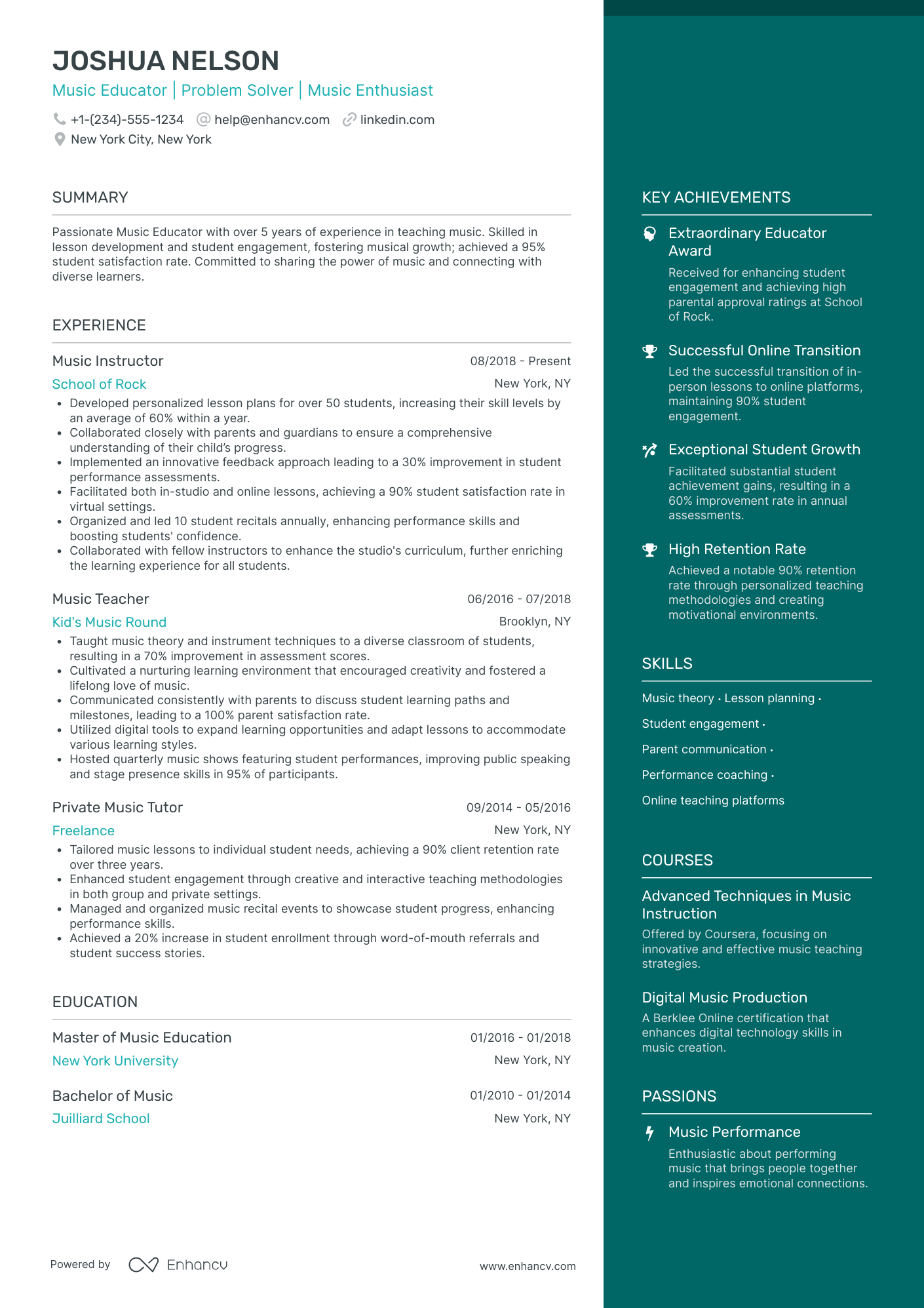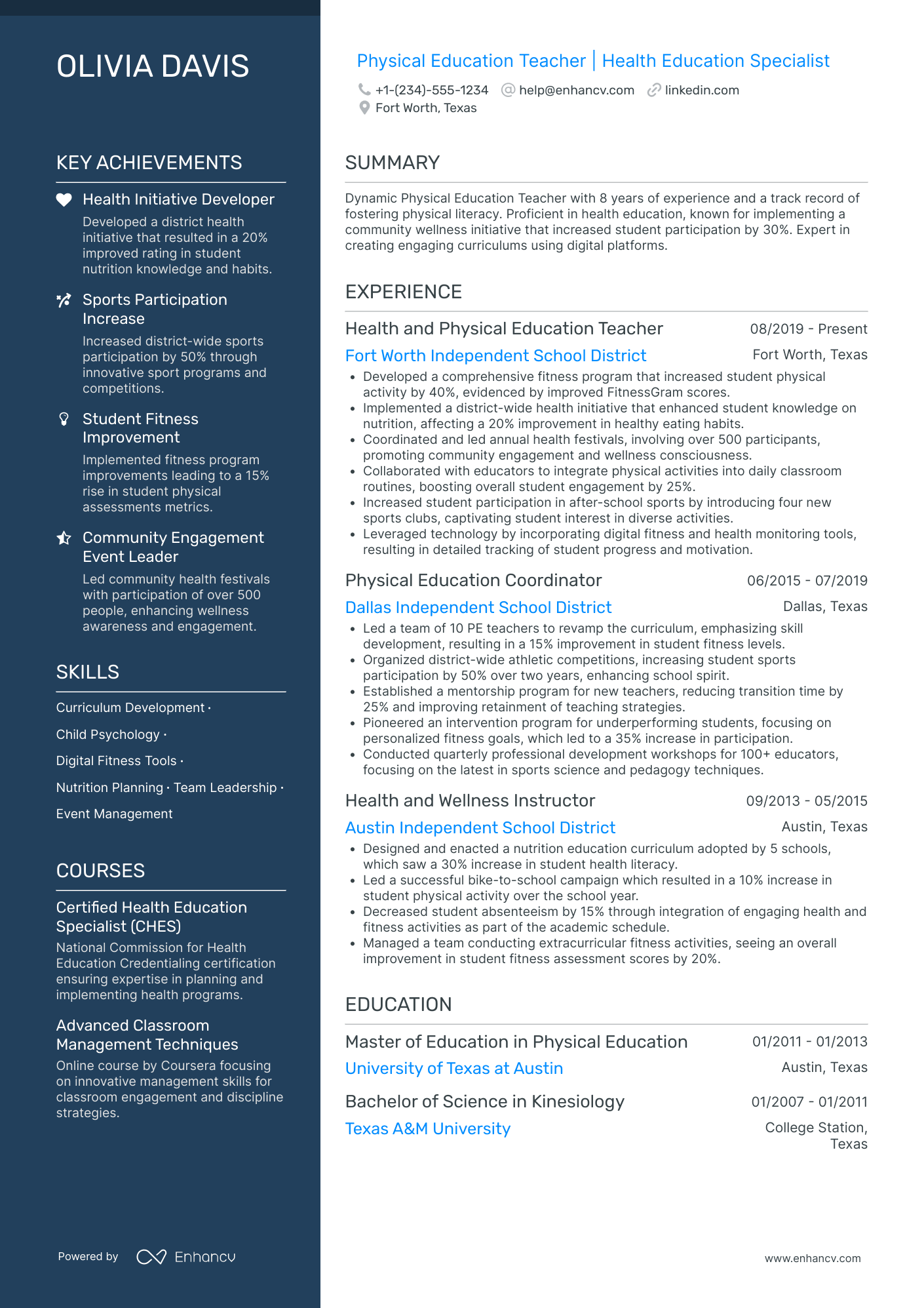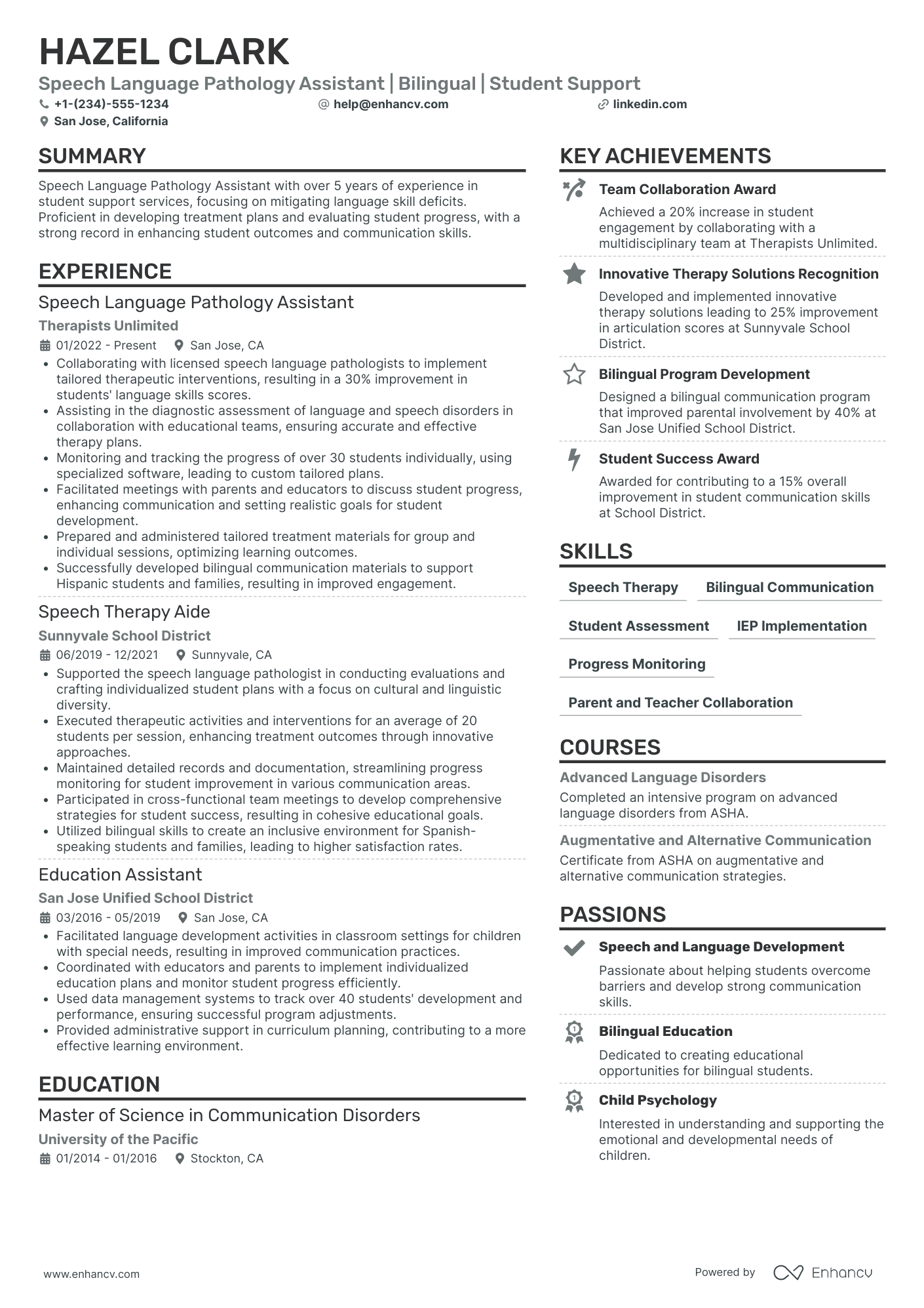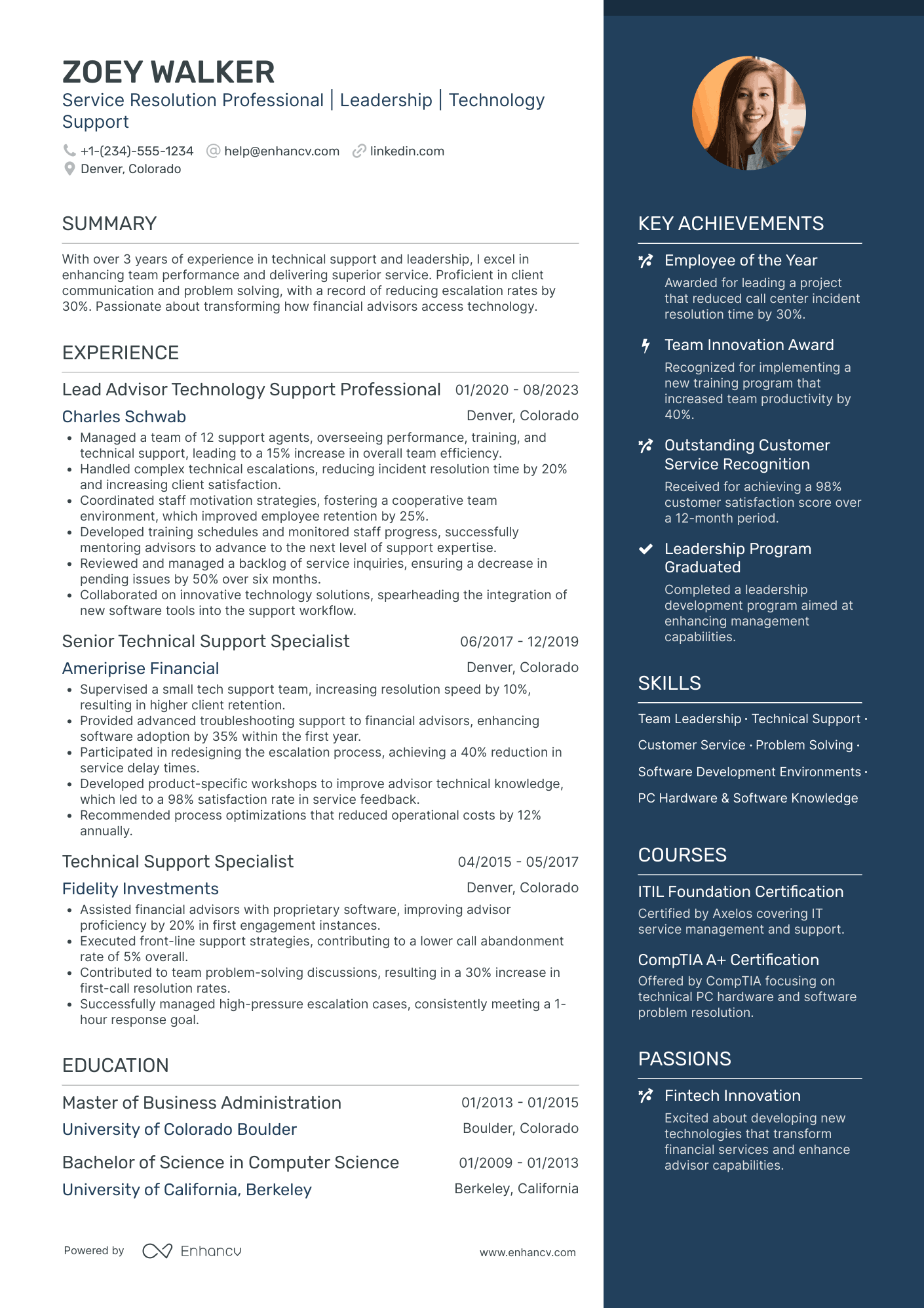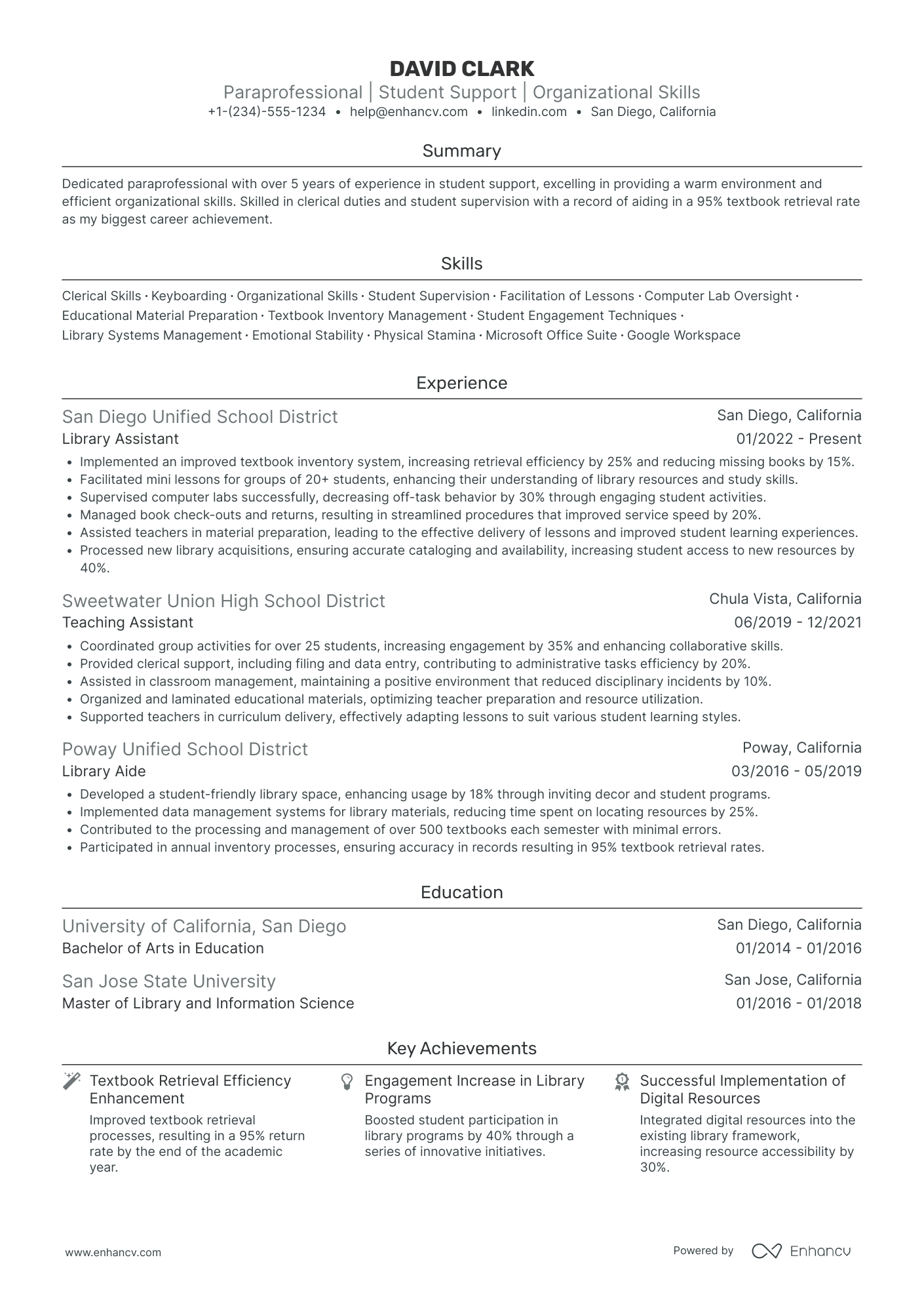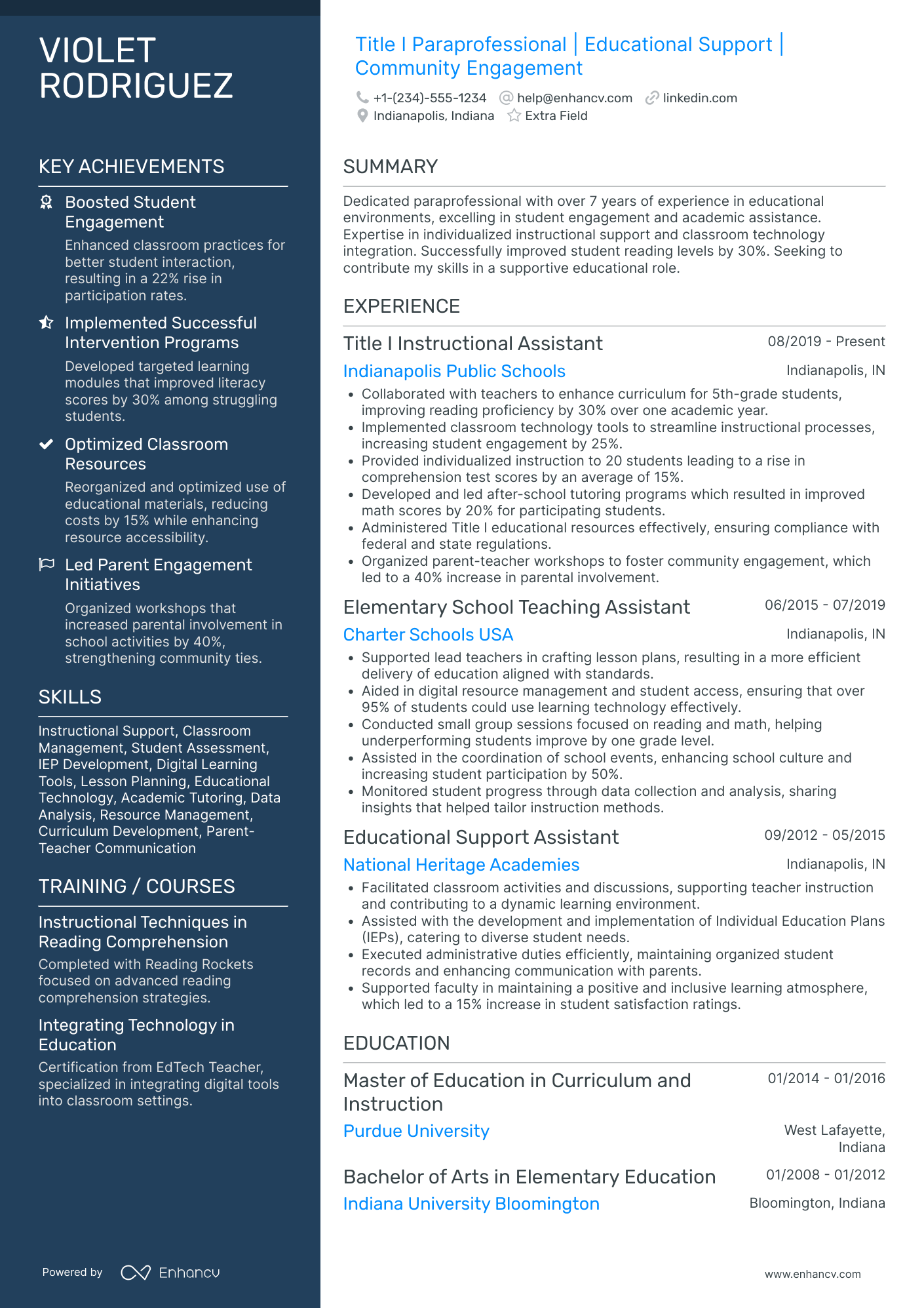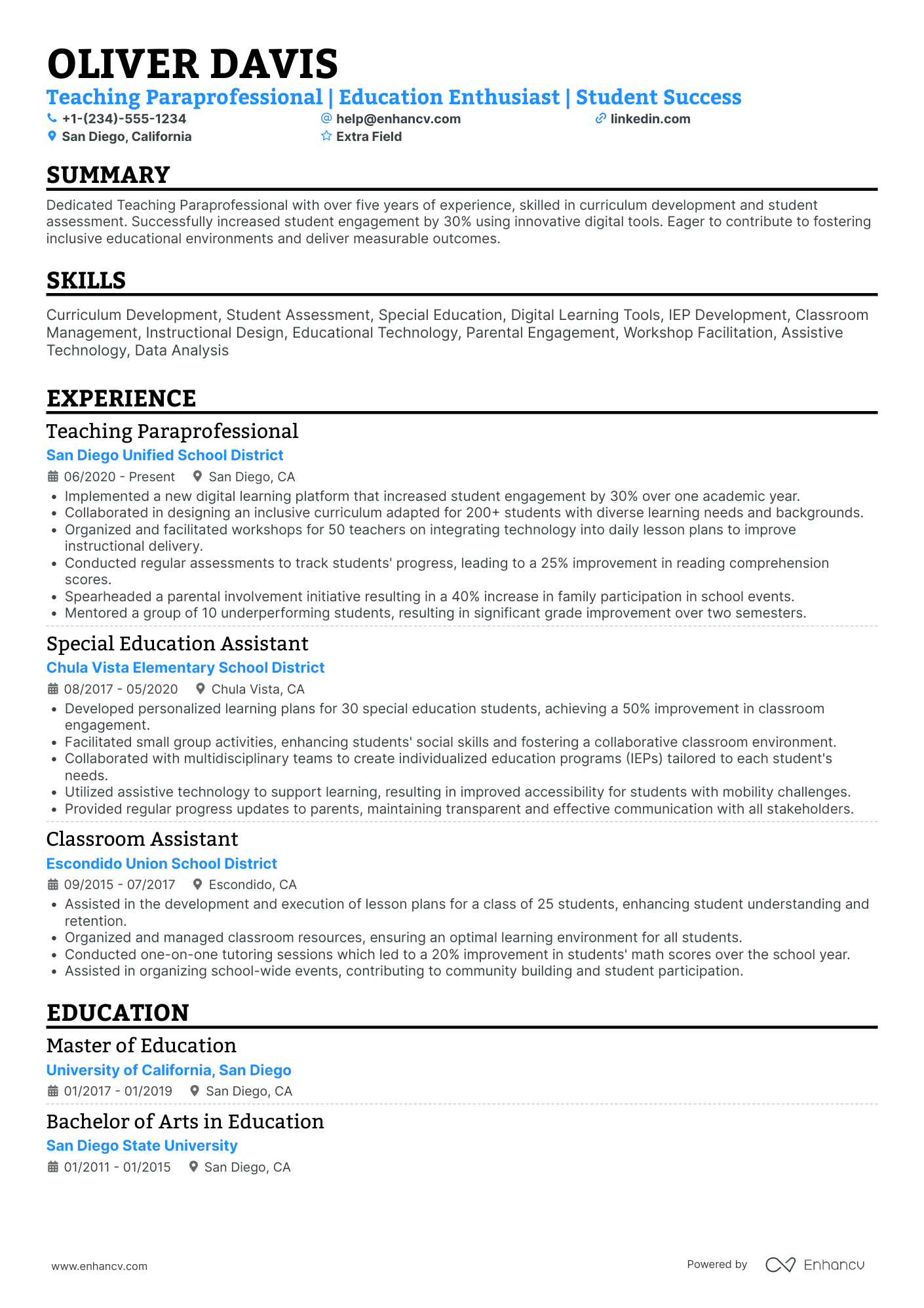As a paraprofessional, articulating your diverse support skills and classroom contributions in a resume can be a daunting challenge. Our guide provides targeted advice on how to effectively showcase your educational support expertise and make your application stand out to potential employers.
- Aligning the top one-third of your paraprofessional resume with the role you're applying for.
- Curating your specific paraprofessional experience to get the attention of recruiters.
- How to list your relevant education to impress hiring managers recruiting for the paraprofessional role.
Discover more paraprofessional professional examples to help you write a job-winning resume.
Best Practices for the Look and Feel of Your Paraprofessional Resume
Before you even start writing your paraprofessional resume, first you need to consider its layout and format.
What's important to keep in mind is:
- The reverse-chronological resume is the most widely used format to present your experience, starting with your latest job.
- Your paraprofessional resume header needs to include your correct, professional contact details. If you happen to have a professional portfolio or an updated LinkedIn profile, include a link to it.
- Ensure your resume is no longer than two pages - you don't have to include irelevant experience on your resume just to make it look longer.
- Unless specified otherwise, submit your resume in the most popular format, the PDF one, as this will ensure your paraprofessional resume isn't altered.
Think about the location of your application – Canadian resumes, for instance, might follow a different structure.
Upload & Check Your Resume
Drop your resume here or choose a file. PDF & DOCX only. Max 2MB file size.
PRO TIP
Listing your relevant degrees or certificates on your paraprofessional resume is a win-win situation. Not only does it hint at your technical capabilities in the industry, but an array of soft skills, like perseverance, adaptability, and motivation.
Essential sections that should make up your paraprofessional resume include:
- The header - with your contact details (e.g. email and telephone number), link to your portfolio, and headline
- The summary (or objective) - to spotlight the peaks of your professional career, so far
- The experience section - with up to six bullets per role to detail specific outcomes
- The skills list - to provide a healthy mix between your personal and professional talents
- The education and certification - showing your most relevant degrees and certificates to the paraprofessional role
What recruiters want to see on your resume:
- Experience working with special needs or diverse student populations
- Knowledge of educational software and assistive technology
- Ability to implement and modify instructional support under the direction of a teacher
- Strong communication and interpersonal skills for interaction with students, teachers, and parents
- Behavior management techniques and experience with classroom organization
What to Include in the Experience Section of Your Paraprofessional Resume
The resume experience section is perhaps the most important element in your application as it needs to showcase how your current profile matches the job.
While it may take some time to perfect your paraprofessional experience section, here are five tips to keep in mind when writing yours:
- Assess the advert to make a list of key requirements and look back on how each of your past jobs answers those;
- Don't just showcase you know a particular skill, instead, you need proof in the form of tangible results (e.g. numbers, percent, etc.);
- It's perfectly fine to leave off experience items that don't bring anything extra to your skill set or application;
- Recruiters want to understand what the particular value is of working with you, so instead of solely featuring technologies, think about including at least one bullet that's focused on your soft skills;
- Take care with wording each bullet to demonstrate what you've achieved, using a particular skill, and an action verb.
The below paraprofessional resume examples can help guide you to curate your professional experience, following industry-leading tips and advice.
- Collaborated with special education teachers to adapt curriculum for 30 students with diverse learning disabilities, elevating student engagement by 25%.
- Facilitated bi-weekly workshops for paraprofessionals on behavior management strategies, improving classroom behavior by 40%.
- Managed documentation and progress tracking for Individual Education Plans, achieving a 95% success rate in meeting students’ academic goals.
- Oversaw a team of 10 paraprofessionals, providing mentorship and training that led to a 30% increase in team productivity.
- Designed and implemented an inclusive classroom model serving 50+ students, effectively integrating 10 children with special needs into mainstream classrooms.
- Led quarterly parent-teacher conferences, fostering strong relationships that resulted in a 20% increase in parental involvement in school activities.
- Provided targeted support for 15 students with dyslexia using multisensory instruction techniques, helping them improve reading levels by an average of two grades.
- Managed classroom technology integration, including SMART Boards and educational software, contributing to a 35% increase in student engagement.
- Organized and led after-school tutoring, which served 100+ students annually and contributed to a 10% improvement in standardized test scores.
- Implemented behavior modification plans for 20 students with challenging behaviors, reducing classroom interruptions by 50%.
- Conducted daily data collection on students' behavioral progress and communicated findings to the interdisciplinary team, informing adjustments to individualized strategies.
- Organized community-based instruction outings, which helped students develop practical life skills and increased community participation by 60%.
- Assist with the instruction of 25 fourth-grade students, helping to raise the class average on standardized math tests by 15%.
- Engage students through creative lesson plans that incorporate technology, resulting in a 25% increase in student participation and collaboration.
- Coordinate with the lead teacher to implement individualized accommodations for 5 students with physical disabilities, ensuring full access to the learning environment.
- Developed personalized educational activities for students with autism, leading to a visible improvement in social skills and academic engagement for a cohort of 12.
- Facilitated sensory integration sessions, resulting in a 40% decrease in sensory overload incidents for students with ASD.
- Collaborated with occupational therapists to create a supportive classroom environment that improved students’ fine motor skills and classroom participation by 20%.
- Supported the language development of 40 bilingual students, contributing to a 50% improvement in English proficiency test scores over four years.
- Cultivated a multicultural classroom environment that respected and celebrated students' diverse backgrounds, significantly improving cultural awareness within the school.
- Developed supplemental bi-lingual educational materials that increased student comprehension across subject areas by 30%.
- Provided 1-on-1 and small group instruction in math and literacy to underperforming students, leading to a 20% improvement in their academic performance.
- Managed intervention strategies for the RTI (Response to Intervention) program for 50 students, aiding in the successful graduation from the program for 85% of participants.
- Spearheaded a summer reading program that engaged over 200 students district-wide, enhancing reading skills and preventing the summer slide.
The following content includes information from "O*NET OnLine" by the U.S. Department of Labor, Employment and Training Administration (USDOL/ETA). Used under the CC BY 4.0 license. The data represents the top responsibilities present on the task lists for paraprofessional professionals.
Top Responsibilities for Paraprofessional:
- Supervise students in classrooms, halls, cafeterias, school yards, and gymnasiums, or on field trips.
- Tutor and assist children individually or in small groups to help them master assignments and to reinforce learning concepts presented by teachers.
- Enforce administration policies and rules governing students.
- Teach social skills to students.
- Instruct and monitor students in the use and care of equipment and materials to prevent injuries and damage.
- Discuss assigned duties with classroom teachers to coordinate instructional efforts.
- Present subject matter to students under the direction and guidance of teachers, using lectures, discussions, supervised role-playing methods, or by reading aloud.
- Clean classrooms.
- Observe students' performance, and record relevant data to assess progress.
- Organize and label materials and display students' work in a manner appropriate for their eye levels and perceptual skills.
Quantifying impact on your resume
- Include the number of students you have supported to demonstrate the breadth of your experience.
- Highlight any increases in student test scores or grades that occurred under your assistance to show your effectiveness.
- Mention the size of educational teams you've collaborated with to illustrate your teamwork capabilities.
- Specify the number of special education plans you have helped implement to exhibit your expertise in individualized education.
- Detail the percentage of classroom integration improvements for special needs students resulting from your support.
- Report on the amount of behavioral interventions conducted and their success rates to showcase your ability to manage challenging situations.
- Quantify the number of teacher support hours provided weekly to convey the extent of your assistance.
- Record the number of training sessions or workshops attended to reflect your commitment to professional development.
Action verbs for your paraprofessional resume
What can candidates do about their resume, if they have no experience
Job requirements can sometimes be answered by other elements you could make more prominent in your paraprofessional resume.
Thus, you'd be substituting your lack of experience with your relevant:
- Education with details of skills you've obtained that align with the job
- Internships and short-term jobs that are once more dedicated to putting your expertise in the spotlight
- Skills section answering basic and - potentially - more specific job qualifications
- Strengths or accomplishments to show the unique value you present, even as a candidate with less or no professional experience in the industry.
Recommended reads:
PRO TIP
Bold the names of educational institutions and certifying bodies for emphasis.
Key Hard Skills and Soft Skills for Your Paraprofessional Resume
At the top of any recruiter paraprofessional checklist, you'd discover a list of technical competencies, balanced with personal skills.
Hard or technical skills are your opportunity to show how you meet the essential responsibilities of the role. The ability to use a particular job-crucial technology or software would also hint to recruiters whether you'd need a prolonged period of on-the-job training - or you'd fit right in the job.
But to land your dream role, you'd also need to demonstrate a variety of soft or people resume skills . Employers care about soft skills as they show how each candidate would fit into the team and company culture.
Both types of skills are specific and to best curate them on your resume, you'd need to:
- Create a skill section within which you showcase your hard and soft skills and present how they help you succeed.
- List specific examples of projects, tasks, or competitions, within which your skill set has assisted your results.
- Soft skills are harder to measure, so think about situations in which they've helped you thrive. Describe those situations concisely, focusing on how the outcome has helped you grow as a professional.
- Metrics of success - like positive ROI or optimized workplace processes - are the best way to prove your technical and people skills.
Take a look at some of paraprofessional industry leaders' favorite hard skills and soft skills, as listed on their resumes.
Top skills for your paraprofessional resume:
Assistive Technology
Microsoft Office Suite
Google Workspace
Special Education Software
Data Entry Tools
Learning Management Systems (LMS)
Behavioral Management Tools
Communication Devices
Scheduling Software
Record Keeping Systems
Communication
Empathy
Patience
Teamwork
Adaptability
Problem-Solving
Organization
Critical Thinking
Time Management
Conflict Resolution
Next, you will find information on the top technologies for paraprofessional professonals from "O*NET OnLine" by the U.S. Department of Labor, Employment and Training Administration (USDOL/ETA). Used under the CC BY 4.0 license.
Top technologies for Paraprofessional’s resume:
- Email software
- Microsoft Outlook
- Padlet
- Schoology
- ParentSquare
- Tadpoles
PRO TIP
If you happen to have plenty of certificates, select the ones that are most applicable and sought-after across the industry. Organize them by relevance to the role you're applying for.
Including Your Education and Certification on Your Paraprofessional Resume
The significance of your resume education section is paramount. It can show your diverse talents and experiences that are relevnt to the position.
- Incorporate educational qualifications, mentioning the institution and period.
- If you're on your academic journey, pinpoint your expected completion date.
- Opt for leaving out degrees that don't serve the job's purpose.
- Provide an overview of your educational experiences if it spotlights your milestones.
When recruiting for paraprofessional roles, candidates with relevant education and certification definitely stand out amongst competitors.
Showcase your academic background in the best way possible by:
- Listing all degrees and certifications that are part of the candidate qualifications in the paraprofessional advert
- Including any extra certificates, if they make sense to your application
- Not going over the top in details - the certificate name, institution, and dates are enough
- If you're in the process of obtaining a degree or certificate that's relevant to the job, include your expected graduation/certification dates
The education and certification sections help back up your application with years of experience in the industry or niche.
Select some of the most cutting-edge or applicable credentials for your next paraprofessional application from our list:
The top 5 certifications for your paraprofessional resume:
- Special Education paraprofessional Credential (SEPC) - National Association of Special Education Teachers (NASET)
- Paraprofessional Educator Endorsement (PEE) - State Departments of Education or Local School Districts
- Certified paraprofessional (CPara) - American Federation of Teachers (AFT)
- No Child Left Behind paraprofessional Certification (NCLBPC) - State Education Agencies
- Autism Certificate (AC) - International Board of Credentialing and Continuing Education Standards (IBCCES)
The content below includes information from "O*NET OnLine" by the U.S. Department of Labor, Employment and Training Administration (USDOL/ETA). Used under the CC BY 4.0 license. The data represents the top associations for paraprofessional professionals.
Top US associations for a Paraprofessional professional
- American Educational Research Association
- American Federation of State, County and Municipal Employees, AFL-CIO
- American Federation of Teachers, AFL-CIO
- American Montessori Society
- Association for Early Learning Leaders
PRO TIP
The more time and effort you've put into obtaining the relevant certificate, the closer to the top it should be listed. This is especially important for more senior roles and if the company you're applying for is more forward-facing.
Recommended reads:
Practical Guide to Your Paraprofessional Resume Summary Or Objective
First off, should you include a summary or objective on your paraprofessional resume?
We definitely recommend you choose the:
- Resume summary to match job requirements with most noteworthy accomplishments.
- Resume objective as a snapshot of career dreams
Both the resume summary and objective should set expectations for recruiters as to what your career highlights are.
These introductory paragraphs (that are no more than five sentences long) should help you answer why you're the best candidate for the job.
Industry-wide best practices pinpoint that the paraprofessional resume summaries and objectives follow the structures of these samples:
Resume summaries for a paraprofessional job
- Dedicated Special Education paraprofessional with 5+ years of experience supporting the facilitation of inclusive classroom environments. Proficient in the development and implementation of individualized education plans (IEPs) and behavioral intervention strategies. Recognized for fostering student independence and championing a significant improvement in literacy among students with dyslexia.
- Diligent Educational Assistant transitioning from a successful 10-year career as a child psychologist to a role assisting students with special needs. Offers distinguished expertise in cognitive behavioral techniques and a profound understanding of learning disabilities, aiming to support personalized education and promote each student's unique potential.
- Enthusiastic former Human Resources specialist making a career shift, eager to apply 8 years of experience in training and development to support diverse learning environments as a paraprofessional. Committed to employing adept communication skills and building strong rapport to facilitate student success and classroom harmony.
- Adept Secondary-level paraprofessional specialized in providing academic support to at-risk youth, with 3 years of hands-on experience. Recognized for leveraging strong mentorship skills to increase graduation rates by 15%. Skilled in conflict resolution and creating engaging learning materials to cater to individual student needs.
- Motivated individual with a passion for community service and education, seeking to apply a fresh perspective and strong interpersonal skills to promote inclusive education as a first-time paraprofessional. Eager to contribute to the cultivation of a supportive learning environment where every student has the opportunity to thrive.
- Aspiring paraprofessional with a background in youth volunteer work, possessing strong organizational and communication skills. Intent on supporting educators to provide comprehensive support to students, while pursuing professional development in special education methodologies and classroom management techniques.
Optimize your resume summary and objective for ATS
Drop your resume here or choose a file.
PDF & DOCX only. Max 2MB file size.
Average Salary Info by State in the US for Paraprofessional Professionals
Local salary info for Paraprofessional.” Source: My Next Move, National Center for O*NET Development. Accessed 10/15/2024
| State | Average Salary (in USD) |
|---|---|
| US National Average | $35,550 |
| California (CA) | $45,080 |
| Texas (TX) | $29,360 |
| Florida (FL) | $30,310 |
| New York (NY) | $37,020 |
| Pennsylvania (PA) | $32,220 |
| Illinois (IL) | $35,730 |
| Ohio (OH) | $35,430 |
| Georgia (GA) | $28,770 |
| North Carolina (NC) | $27,500 |
| Michigan (MI) | $30,670 |
Taking Your Paraprofessional Resume to the Next Level with These Four Additional Resume Sections
Your paraprofessional resume can feature a variety of skills (both hard and soft) in diverse sections. Choose those that align best with the job requirements and reflect your suitability for the company culture.
Consider these four additional resume sections recommended by our experts:
- Languages - State any languages you are proficient in and your level of proficiency. This demonstrates your commitment to communication and potential for international growth.
- Projects - Highlight up to three significant projects you've completed outside of work, showcasing skill development. Include a link to your project portfolio in the paraprofessional resume header, if applicable.
- My Time - How you allocate your time outside work can indicate your organizational skills and cultural fit within the company.
- Volunteering - Detail causes you're passionate about, roles you've held, and achievements in volunteering. Such experiences likely have honed a range of soft skills crucial for your dream job.
Key Takeaways
We've reached the end of our paraprofessional resume guide and hope this information has been useful. As a summary of our key points:
- Always assess the job advert for relevant requirements and integrate those buzzwords across various sections of your paraprofessional resume by presenting tangible metrics of success;
- Quantify your hard skills in your certificates and skills section, while your soft skills in your resume achievements section;
- Ensure you've added additional relevant experience items, such as extracurricular activities and projects you've participated in or led;
- Use both your resume experience and summary to focus on what matters the most to the role: including your technical, character, and cultural fit for the company.
Paraprofessional resume examples
By Role
